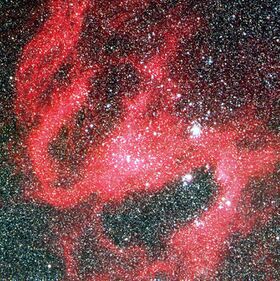Astronomy:R85
 The nebula N119; R85 is the brightest of the small triangle of stars in the lower right "arm". Credit: ESO | |
| Observation data Equinox J2000.0]] (ICRS) | |
|---|---|
| Constellation | Dorado |
| Right ascension | 05h 17m 56.076s[1] |
| Declination | −69° 16′ 03.77″[1] |
| Apparent magnitude (V) | 10.84[2] (10.65 - 10.80[3]) |
| Characteristics | |
| Evolutionary stage | LBV[4] |
| Spectral type | B5 Iae[3] |
| Apparent magnitude (U) | 10.28[2] |
| Apparent magnitude (B) | 10.93[2] |
| Apparent magnitude (V) | 10.84[2] |
| Apparent magnitude (R) | 10.53[2] |
| Apparent magnitude (I) | 10.44[2] |
| Apparent magnitude (J) | 10.103[1] |
| Apparent magnitude (H) | 9.980[1] |
| Apparent magnitude (K) | 9.822[1] |
| U−B color index | −0.65[2] |
| B−V color index | +0.09[2] |
| Variable type | LBV[4] |
| Astrometry | |
| Radial velocity (Rv) | 292[5] km/s |
| Proper motion (μ) | RA: −1.0[6] mas/yr Dec.: −2.3[6] mas/yr |
| Distance | 160,000 ly (50,000[7] pc) |
| Absolute magnitude (MV) | −8.2 – −8.5[3] |
| Details | |
| 1960 (minimum) | |
| Radius | 135[8] R☉ |
| Luminosity | 350,000[3] L☉ |
| Temperature | 13,500[3] K |
| 1983 - 1990 (maximum) | |
| Luminosity | 315,000[3] L☉ |
| Temperature | 10,000[3] K |
| Other designations | |
| Database references | |
| SIMBAD | data |
R85 (or RMC 85, after the Radcliffe Observatory Magellanic Clouds catalog[5]) is a candidate luminous blue variable[9] located in the LH-41 OB association[10] in the Large Magellanic Cloud.

R85 has been shown to vary erratically in brightness with an amplitude of about 0.3 magnitudes. It shows variations on several timescales, sometimes with a distinct 400 day period. It has also shown temperature changes associated with brightness changes over several years, a characteristic of luminous blue variables.[12]
Based on R85's current properties and evolutionary models, it probably started out with an initial mass of 28 M☉.[10] It is theorized to be making a bubble known as DEM L132a with its stellar wind in the nebula LHA-120 N119, along with S Doradus.[13] It has an infrared excess consistent with a stellar wind contribution.[4]
References
- ↑ 1.0 1.1 1.2 1.3 1.4 Cutri, Roc M.; Skrutskie, Michael F.; Van Dyk, Schuyler D.; Beichman, Charles A.; Carpenter, John M.; Chester, Thomas; Cambresy, Laurent; Evans, Tracey E. et al. (2003). "VizieR Online Data Catalog: 2MASS All-Sky Catalog of Point Sources (Cutri+ 2003)". CDS/ADC Collection of Electronic Catalogues 2246: II/246. Bibcode: 2003yCat.2246....0C. http://vizier.u-strasbg.fr/viz-bin/VizieR?-source=II/246.
- ↑ 2.0 2.1 2.2 2.3 2.4 2.5 2.6 2.7 Ducati, J. R. (2002). "VizieR Online Data Catalog: Catalogue of Stellar Photometry in Johnson's 11-color system". CDS/ADC Collection of Electronic Catalogues 2237. Bibcode: 2002yCat.2237....0D.
- ↑ 3.0 3.1 3.2 3.3 3.4 3.5 3.6 Van Genderen, A. M. (2001). "S Doradus variables in the Galaxy and the Magellanic Clouds". Astronomy and Astrophysics 366 (2): 508–531. doi:10.1051/0004-6361:20000022. Bibcode: 2001A&A...366..508V.
- ↑ 4.0 4.1 4.2 Bonanos, A. Z.; Massa, D. L.; Sewilo, M.; Lennon, D. J.; Panagia, N.; Smith, L. J.; Meixner, M.; Babler, B. L. et al. (2009). "Spitzersage Infrared Photometry of Massive Stars in the Large Magellanic Cloud". The Astronomical Journal 138 (4): 1003–1021. doi:10.1088/0004-6256/138/4/1003. Bibcode: 2009AJ....138.1003B.
- ↑ 5.0 5.1 Feast, M. W.; Thackeray, A. D.; Wesselink, A. J. (1960). "The brightest stars in the Magellanic Clouds". Monthly Notices of the Royal Astronomical Society 121 (4): 337. doi:10.1093/mnras/121.4.337. Bibcode: 1960MNRAS.121..337F.
- ↑ 6.0 6.1 Høg, E.; Fabricius, C.; Makarov, V. V.; Urban, S.; Corbin, T.; Wycoff, G.; Bastian, U.; Schwekendiek, P. et al. (2000). "The Tycho-2 catalogue of the 2.5 million brightest stars". Astronomy and Astrophysics 355: L27. Bibcode: 2000A&A...355L..27H.
- ↑ Aldoretta, E. J.; Caballero-Nieves, S. M.; Gies, D. R.; Nelan, E. P.; Wallace, D. J.; Hartkopf, W. I.; Henry, T. J.; Jao, W.-C. et al. (2015). "The Multiplicity of Massive Stars: A High Angular Resolution Survey with the Guidance Sensor". The Astronomical Journal 149 (1): 26. doi:10.1088/0004-6256/149/1/26. Bibcode: 2015AJ....149...26A.
- ↑ Stahl, O.; Wolf, B.; Leitherer, C.; Zickgraf, F.-J.; Krautter, J.; De Groot, M. (1984). "Variable blue supergiants in the Large Magellanic Cloud - R 84, R 85, and R 99". Astronomy and Astrophysics 140: 459. Bibcode: 1984A&A...140..459S.
- ↑ Richardson, Noel D.; Mehner, Andrea (2018). "The 2018 Census of Luminous Blue Variables in the Local Group". Research Notes of the American Astronomical Society 2 (3): 121. doi:10.3847/2515-5172/aad1f3. Bibcode: 2018RNAAS...2..121R.
- ↑ 10.0 10.1 Smith, Nathan; Tombleson, Ryan (2015). "Luminous blue variables are antisocial: Their isolation implies that they are kicked mass gainers in binary evolution". Monthly Notices of the Royal Astronomical Society 447 (1): 598–617. doi:10.1093/mnras/stu2430. Bibcode: 2015MNRAS.447..598S.
- ↑ "ASAS-SN Variable Stars Database". ASAS-SN. https://asas-sn.osu.edu/variables/lookup.
- ↑ Van Genderen, A. M.; Sterken, C.; De Groot, M. (1998). "Light variations of massive stars (alpha Cyg variables). XVI. The LMC supergiants R 85 (LBV) and R 110 (LBV) and the SMC supergiants R 42 and R 45". Astronomy and Astrophysics 337: 393. Bibcode: 1998A&A...337..393V.
- ↑ Ambrocio-Cruz, P.; Rosado, M.; Laval, A.; Le Coarer, E.; Russeil, D.; Amram, P. (2008). "Kinematic field of the S-shaped nebula N119 in the LMC". Revista Mexicana de Astronomía y Astrofísica 44: 355. Bibcode: 2008RMxAA..44..355A.
 |
